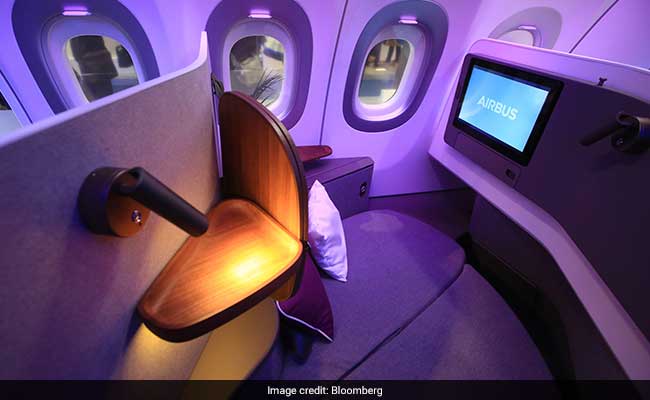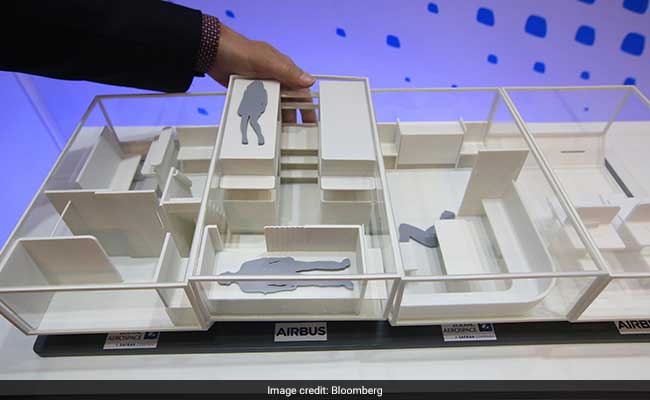
The Airspace XL Bin boasts 60 per cent more capacity and will make its debut on American Airlines A320
As planemakers focus on delivering record jetliner backlogs at the expense of designing new models, airlines are keener than ever to secure an edge over rivals with the latest onboard upgrades and gizmos.
That might mean snazzy new business seats each costing more than a family car, or cheap and cheerful innovations aimed at making 10 hours in coach just a little more bearable.
The 2018 Aircraft Interiors Expo in Hamburg -- the industry's biggest event devoted solely to the inside of the aircraft -- featured the following highlights, some more likely to make it to market than others:
Serve-Yourself Nibbles
Tired of waiting for the food trolley to went its way slowly to your seat? Switzerland's Bucher Aerospace is developing a galley for wide-body aircraft that doubles as a food kiosk, allowing passengers to wander up for peanuts or a soft drink at any time. The technology also features electronic inventory management, so that flight attendants will know for sure if there's another vegetarian meal on board and where it's hiding. With Bucher offering insulated trolleys for at-seat dining, the kitchen has no need for a cooling unit, shaving 200 kilograms off the weight of the aircraft.
 Tweets In The Bathroom
Tweets In The Bathroom
Airbus SE is seeking to improve the ambience of aircraft washrooms by piping in a soundtrack of birdsong. Sound engineers will take the background noise of the aircraft engine as the basic element and compose fitting accompaniments from the dawn chorus to be played over the top.
Seats That Snitch
Soisa Aircraft Interiors of Mexico showcased technology that integrates ambient lighting into the seat headrest. The advantage: you find your place faster, and the seat can point you toward the nearest emergency exit. On the other hand, the color-scheme can also tell the flight attendant -- and those around you -- if you're not buckled up when the warning light is on, leading to an embarrassing moment but potentially saving airlines millions in damages claims from passengers who suffer bumps and bruises during turbulence.
Standing Room Only
Plane washrooms are a focus for designers because they add weight but provide zero revenue. Zodiac Aerospace is offering a modification that converts one of four lavatories in the center of a wide-body jet into two urinals. That means shorter lines for male passengers, and would allow another facility to be made female-only. Deployed in the rear of an aircraft, the same design could create space for a cubicle accessible to people with disabilities.
An End To Bag Wars?
One innovation that's about to become a reality is an overhead luggage compartment that could make squabbles for the last empty locker a thing of the past. Designed by FACC AG for Airbus, the Airspace XL Bin boasts capacity for 60 percent more bags and will make its debut on American Airlines A320 aircraft next year. Items are stored vertically and the bin expands into the aisle to create extra space, while still allowing the person in the aisle seat to stand upright. The design is based on luggage allowance data for 120 airlines and scrutiny of thousands of actual bags, including wheels and handles.
 Smarter Seats
Smarter Seats
Qatar Airways last year revealed what it reckons will be game-changing seats allowing groups of passengers to sit facing each other, but other approaches offer similar flexibility. Airbus is promoting Paperclip Design's "Butterfly'' berth featuring a lie-flat bed that can be converted into two premium-economy seats if corporate bookings dry up. And it takes a cabin attendant just one minute to make the change. Seat weight is another major focus, with Britain's Rebel.aero developing a concept model that features only 40 components and weighs 6 kilos -- half of the current standard. The middle berth of three can also be shifted forward a few inches to allow all passengers to use their armrests, and the seat pad can be partially folded, helping children to sit more easily and giving passengers a bigger area to stand up in.
Sleeping In The Hold
Airbus made Hamburg headlines with a plan to offer passengers sleeper compartments in the cargo holds of A330 jets. In fact the design utilizes existing sleep space set aside for crew, something that's not required on shorter long-haul trips. Passengers would keep their regular seats for take-off and landing and snooze in between. The space could also be used for a meeting room and children's play area, though there'll be no windows.
That might mean snazzy new business seats each costing more than a family car, or cheap and cheerful innovations aimed at making 10 hours in coach just a little more bearable.
The 2018 Aircraft Interiors Expo in Hamburg -- the industry's biggest event devoted solely to the inside of the aircraft -- featured the following highlights, some more likely to make it to market than others:
Serve-Yourself Nibbles
Tired of waiting for the food trolley to went its way slowly to your seat? Switzerland's Bucher Aerospace is developing a galley for wide-body aircraft that doubles as a food kiosk, allowing passengers to wander up for peanuts or a soft drink at any time. The technology also features electronic inventory management, so that flight attendants will know for sure if there's another vegetarian meal on board and where it's hiding. With Bucher offering insulated trolleys for at-seat dining, the kitchen has no need for a cooling unit, shaving 200 kilograms off the weight of the aircraft.

Paperclip Design's Butterfly convertible bed-seat features a lie-flat bed that can be converted into two premium-economy seats
Airbus SE is seeking to improve the ambience of aircraft washrooms by piping in a soundtrack of birdsong. Sound engineers will take the background noise of the aircraft engine as the basic element and compose fitting accompaniments from the dawn chorus to be played over the top.
Seats That Snitch
Soisa Aircraft Interiors of Mexico showcased technology that integrates ambient lighting into the seat headrest. The advantage: you find your place faster, and the seat can point you toward the nearest emergency exit. On the other hand, the color-scheme can also tell the flight attendant -- and those around you -- if you're not buckled up when the warning light is on, leading to an embarrassing moment but potentially saving airlines millions in damages claims from passengers who suffer bumps and bruises during turbulence.
Standing Room Only
Plane washrooms are a focus for designers because they add weight but provide zero revenue. Zodiac Aerospace is offering a modification that converts one of four lavatories in the center of a wide-body jet into two urinals. That means shorter lines for male passengers, and would allow another facility to be made female-only. Deployed in the rear of an aircraft, the same design could create space for a cubicle accessible to people with disabilities.
An End To Bag Wars?
One innovation that's about to become a reality is an overhead luggage compartment that could make squabbles for the last empty locker a thing of the past. Designed by FACC AG for Airbus, the Airspace XL Bin boasts capacity for 60 percent more bags and will make its debut on American Airlines A320 aircraft next year. Items are stored vertically and the bin expands into the aisle to create extra space, while still allowing the person in the aisle seat to stand upright. The design is based on luggage allowance data for 120 airlines and scrutiny of thousands of actual bags, including wheels and handles.

Airbus' cargo sleeper compartments will allow passengers to keep regular seats for take-off, landing and sleep in between
Qatar Airways last year revealed what it reckons will be game-changing seats allowing groups of passengers to sit facing each other, but other approaches offer similar flexibility. Airbus is promoting Paperclip Design's "Butterfly'' berth featuring a lie-flat bed that can be converted into two premium-economy seats if corporate bookings dry up. And it takes a cabin attendant just one minute to make the change. Seat weight is another major focus, with Britain's Rebel.aero developing a concept model that features only 40 components and weighs 6 kilos -- half of the current standard. The middle berth of three can also be shifted forward a few inches to allow all passengers to use their armrests, and the seat pad can be partially folded, helping children to sit more easily and giving passengers a bigger area to stand up in.
Sleeping In The Hold
Airbus made Hamburg headlines with a plan to offer passengers sleeper compartments in the cargo holds of A330 jets. In fact the design utilizes existing sleep space set aside for crew, something that's not required on shorter long-haul trips. Passengers would keep their regular seats for take-off and landing and snooze in between. The space could also be used for a meeting room and children's play area, though there'll be no windows.
Track Latest News Live on NDTV.com and get news updates from India and around the world

